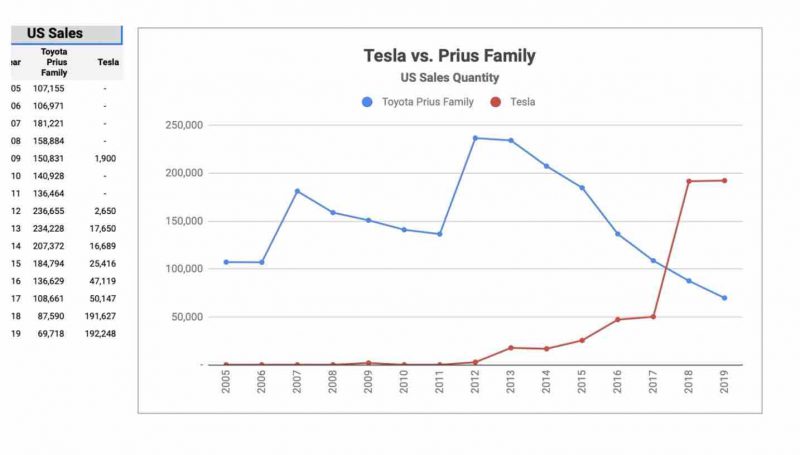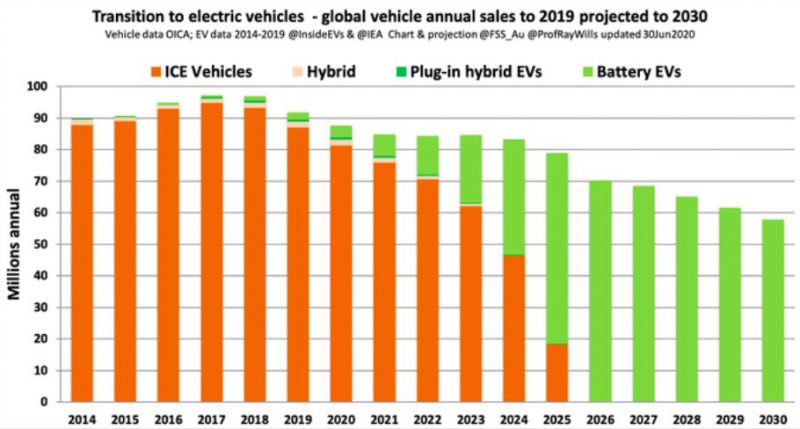It’s taken Tesla just 10 years to end Ice Age for Big Auto and Big Oil
Last week marked the 10th anniversary of the initial public offering of electric vehicle maker Tesla. And CEO Elon Musk and other investors had 324 billion reasons to celebrate: $324 bilion was market value of Tesla (in Australian dollars) at the end of the week.
It’s a phenomenal result by any means.
Tesla hit the boards 10 years ago with a value of $1.7 billion, and since then has delivered an average annual return on that investment of 45 per cent.
In 2019, Tesla made 365,000 electric cars, a fine achievement.
Toyota produced nearly nine million vehicles.
Yet the market is judging Tesla to be the most valuable car company in the world, with a value of $890,000 for every car it made last year.
It’s a market value that seems barely believable by any conventional measure. But this is not about the past, or even the present, but the future.
And this graph perhaps sums up the situation best.
It’s the story of sales of the Toyota Prius and Tesla EVs in the US.
It is significant because it tells of two different strategies – one firmly on the future with no concern about legacy assets, and other with an eye to the past and a determination not to rock the boat, or its business model; and another strategy with the focus firmly on the future, and no legacy distractions.
Toyota won’t die because the Prius has passed it used by date.
And hybrids continue to prove to be enormously popular, more so than Toyota ever expected.
In the last year, more than 60 per cent of sales of popular models such as the RAV4 and the Camry have been the hybrid versions.
But this is the modern equivalent of the fax machine.


Hybrids are easy and convenient, customers get to feel like they are saving money, and lowering emissions, but the company gets to keep its profits, and protect its business model.
But, like the fax machine,
it’s not the answer, it’s just a stepping stone towards more fundamental change.
Hybrids, according to Toyota’s own calculations, deliver maybe a 30 per cent saving in petrol and emissions.
That’s neat, but it’s not enough to meet climate goals, and EVs will be vastly superior.
And when EVs reach cost parity, and the joy of driving them spreads through the population, then the stampede towards electric will be unstoppable.
The latest data tells the story.
Despite the global slowdown in new car sales caused by the Covid-19 pandemic, sales of plug ins and full electrics are going up, and grabbing a greater market share.
It’s the same story in Germany, and Australia, and nearly every other country.
And surveys show that consumers want an EV to be their next vehicle, if the price is right.
So much so, some futurists such as Professor Ray Wills, head of Future Smart Strategies, an adjunct professors at UWA, and director of Horizon Energy, are putting out some stunning forecasts about the pace of transition to electric vehicles.
Take this from last week – a prediction that by 2025, when EVs have well and truly reached cost parity, fossil fuel car sales will be all but over (including hybrids).
The recent ending of fossil fuel car production at VW’s Zwickau plant is a case in point.
‘All major car makers have at least one model of electric vehicle, and have factories able to be retooled to produce electric cars rather than ICE cars,” Wills says.
“Once traditional manufacturers get on with it and retool, the arrival of greater volumes of more affordable EVs will carry the day.
And that take us back to the market valuations of Tesla, Toyota, the other big car manufacturers and big oil.
Investors are interested in recent events, and current profits, but they are more obsessed with what the future holds, and they have voted with their feet.
The highly respected Morgan Stanley analyst Adam Jonas recently noted that Tesla has reached its valuation despite EV penetration being shy of 1 per cent in the US market and roughly 2% globally.
He also noted that if the same multiples on EV production – present and future – that are ascribed to Tesla were to be applied to GM, then that company would be worth around $US100 billion.
The fact that it is not (current market value of GM is $US36 billion) suggests either that the market isn’t looking, or if it is, it is applying a negative value of its petrol and diesel fleet of minus $US60 billion.
The same thing is happening in different ways in Big Oil, a critical part of the Big Auto story because it provide the fuel that the petrol and diesel cars need to burn.
While investors in Big Auto are voting with their feet, directors in Big Oil have one eye on their fiduciary duties.
Big Oil has enjoyed phenomenal market value over recent decades, and because of that access to whatever capital it needs, largely due to the assumed value of resources that it has not yet extracted.
The value of big miners are similarly judged.
And that’s what is killing them now.
BP and Shell have both written off more than $20 billion each in the last few weeks after writing down the value of reserves they now realise will not be extracted.
They’ve seen the future, and it’s not petrol cars.
Big Oil in the US would do the same, were it not for the fact that they can kid themselves that somehow President Donald Trump or the Republicans will throw them a life line.
But they should look carefully at what the big utilities in the US and the coal companies are doing.
The big utilities are making dramatic switches to renewables and storage, and by-passing gas along the way.
The coal companies, one by one, are simply going bankrupt, or closing down.
The European energy giants, where government policy is a lot clearer, have made their own judgement and have been scrambling to restructure – mostly by splitting their business into the new and the old, the good and the bad, the future and the past, the clean and the dirty.
That way they can continue to tap profits from legacy assets up to the point where it is no longer possible, for social, political, environmental or economic reasons. Or a combination of all four.
“Nope, not us,” they will say of their old and dirty portfolio,” look at us now! – it’s all about distributed, digital and democratised energy – renewables and storage, and electric vehicles. Long live the customer!
In short, it’s the end of the ICE Age (internal combustion engine).
That’s two trillion-dollar industries that Elon Musk’s upstart has overturned, with a third – electricity – coming next.
But it will probably take an electric ute – from Tesla, Rivian or even GM, before the penny drops for some.
https://thedriven.io/2020/07/06/tes...f-ice-age-for-two-trillion-dollar-industries/
German new car registrations hit 30-year low, but electric car sales rise
https://thedriven.io/2020/07/06/ger...-hit-30-year-low-but-electric-car-sales-rise/
Tesla increases electric car battery orders from LG Chem
Tesla has placed more orders for electric car batteries with South Korean battery major LG Chem, which will produce them at a US factory in order to meet a growing demand for EV batteries.
Tesla has gone from strength to strength in 2020 despite a downturn due to the Covid-19 pandemic that has legacy car makers feeling the pinch.
On Friday Tesla announced it had delivered 90,000 vehicles in the second quarter of 2020, even though it had reluctantly closed its Fremont factory to comply with stay-at-home measures put in place by California to stem the pandemic.
Since January, Tesla shares have continued to outdo analyst expectations, most recently surging past $US1,200 to cement the EV maker’s new title of most valuable car maker in the world by market cap.
Now, sources have told global news wire Reuters that Tesla is placing orders for more batteries as well as for other components from suppliers.
“Tesla is asking not only LG Chem but other suppliers to increase supplies, as its cars are selling well,” one source told Reuters, reporting that another source said LG Chem will also convert some Korean factories to make more batteries, also for Tesla.
Along with Panasonic (which makes batteries in a joint venture with Tesla in Nevada) and CATL, LG Chem is one of three battery partnerships that Tesla has forged in its missions to disrupt the fossil-fuelled car industry.
It would seem that the South Korean battery maker is also going from strength to strength, with stock values rising from 314,000KRW ($A376.82) in January to 508,000KRW ($A609.64) at market close on Monday.
LG Chem already makes batteries in China for Tesla where it supplies the Shanghai Gigafactory, making it now the second largest EV maker according to Korean electronics news agency The Elec.
Whether the new orders will see it surpass fellow Tesla partner CATL, which currently holds claim to be the largest battery maker in China, will be of interest.
Reuters reports that LG Chem declined to comment on the reports and that Tesla was not available outside business hours for comment.
However, with the new orders, LG Chem may well be on track to outperform both Panasonic and CATL globally.
Data gathered by Adamas Intelligence shows that in the first quarter of 2020 it had edged out Panasonic, producing 6.07GWh battery capacity to Panasonic’s 6.05GWh.
By end April, Adamas Intelligence reports that LG Chem still held the lead with 1.44GWH installed that month, despite CATL taking the lead in terms of production with 1.33GWh manufactured.
Panasonic has since resigned an agreement with Tesla that will see prices locked in for the next three years and guarantee orders for 10 years.
The Elec reports that LG Chem is also ramping up production of batteries using nickel-cobalt-manganese-aluminum (NCMA) anodes, to supply US car giant General Motors.
LG Chem also has a battery factory in Poland that by 2022 will produce 70GWh capacity by 2022 according to the UK’s Faraday Institute, and also has relationships with Volkswagen, PSA and Renault.
https://thedriven.io/2020/07/06/tesla-increases-electric-car-battery-orders-from-lg-chem/
Demand For The Renault ZOE Is Surging In Europe
Renault ZOE may soon see five-digit numbers of new registrations per month.
While the European automotive market is barely on track for gradual recovery after the coronavirus lockdown, the all-electric Renault ZOE is selling like never before.
Number of new registrations in June increased by 107% year-over-year to 10,944.
Renault just boasted that June 2020 was a record-breaking month for the ZOE in terms of new orders - more than 11,000 orders were placed - 11,158 to be precise.
In France, ZOE orders tripled in June (year-over-year) to a new record of 7,050, while in Germany it was 1,990 (up 117% year-over-year)!
We assume that the high demand is caused by revamped EV incentives in many European countries, especially France and Germany.
The refreshed ZOE with its 52 kWh battery and a range of up to 390 km (242 miles) WLTP is one of the top models to consider when looking for a practical, subcompact car for city driving.
https://insideevs.com/news/432222/demand-renault-zoe-surging-europe/
BYD Delivers 150 More Electric Buses In Chile
https://insideevs.com/news/431577/byd-delivered-150-more-electric-buses-chile/


Add to My Watchlist
What is My Watchlist?






